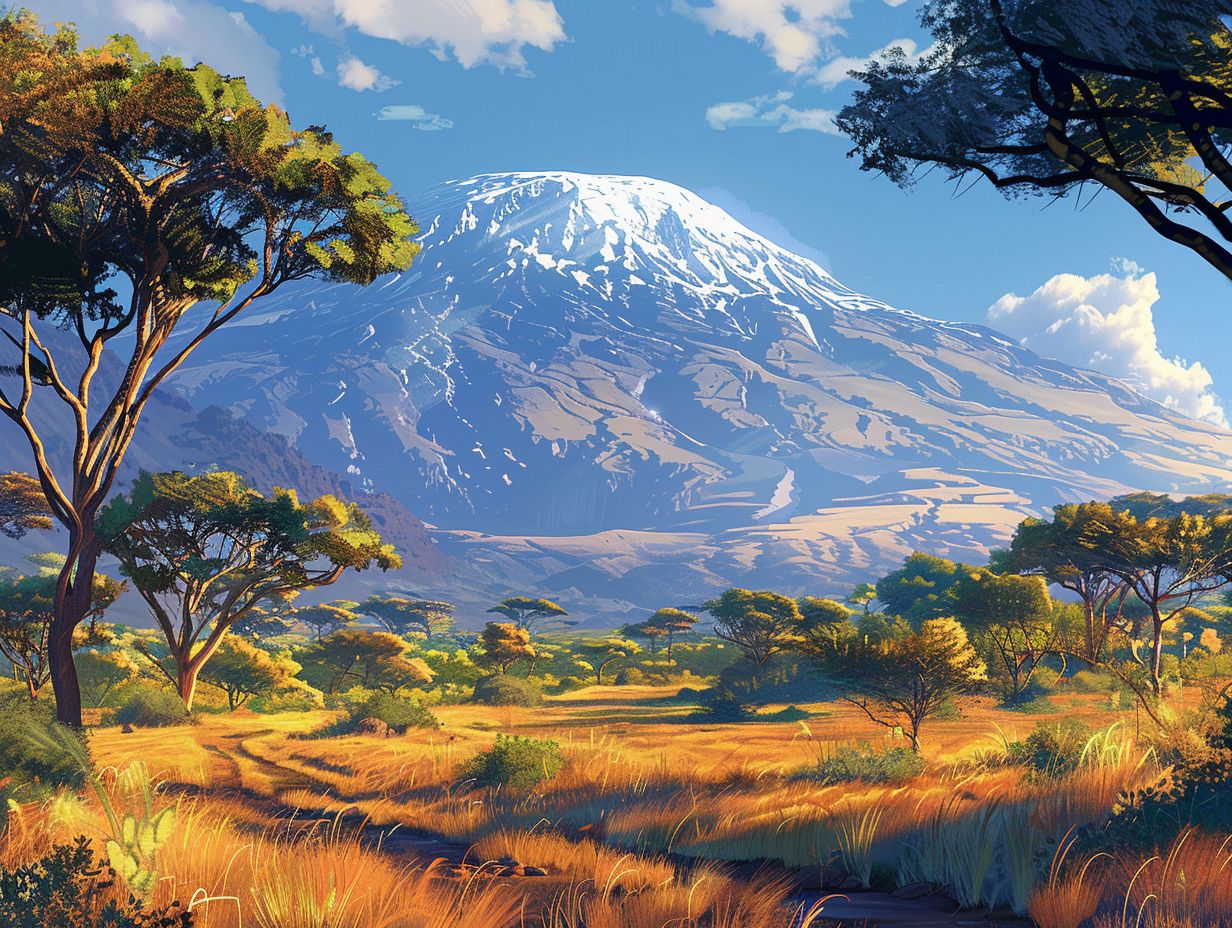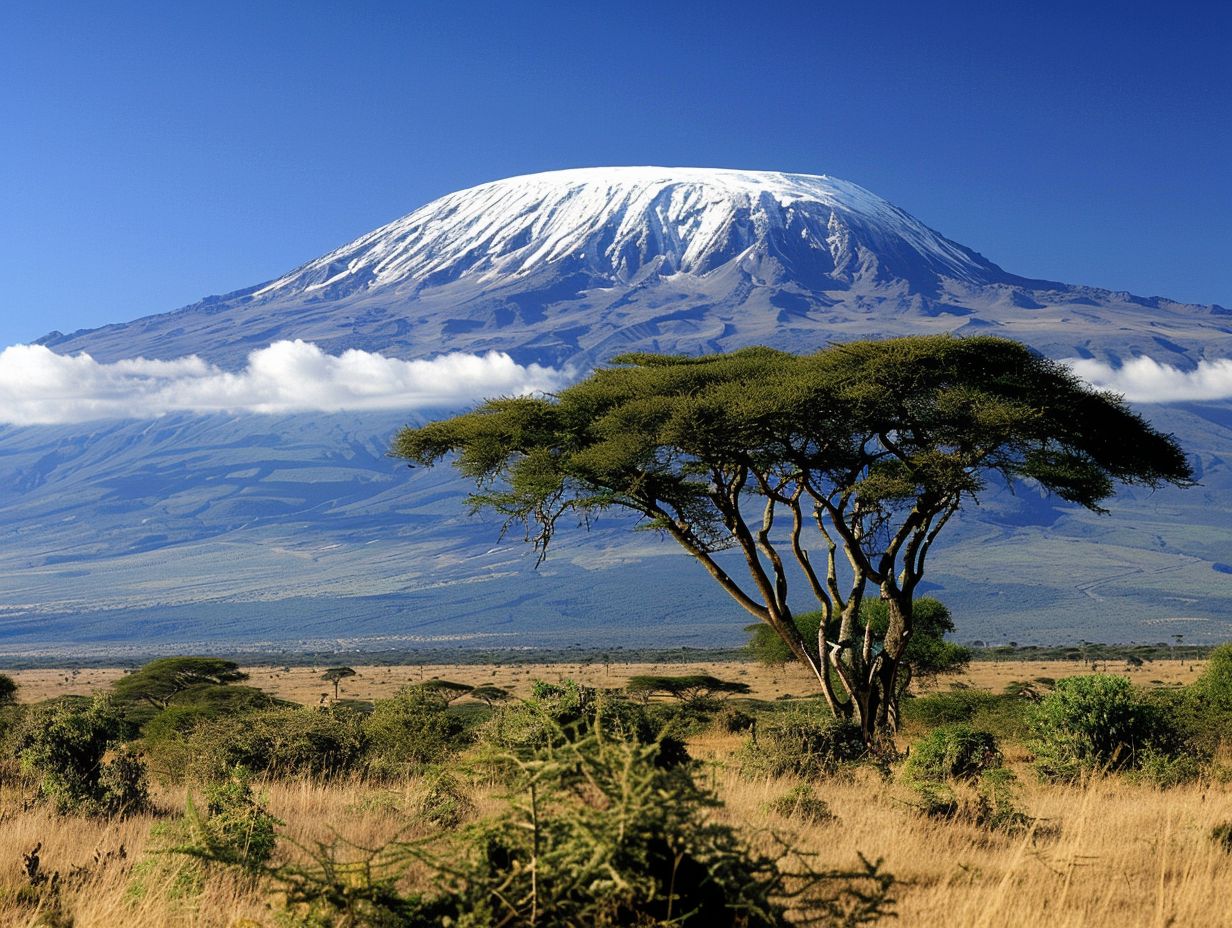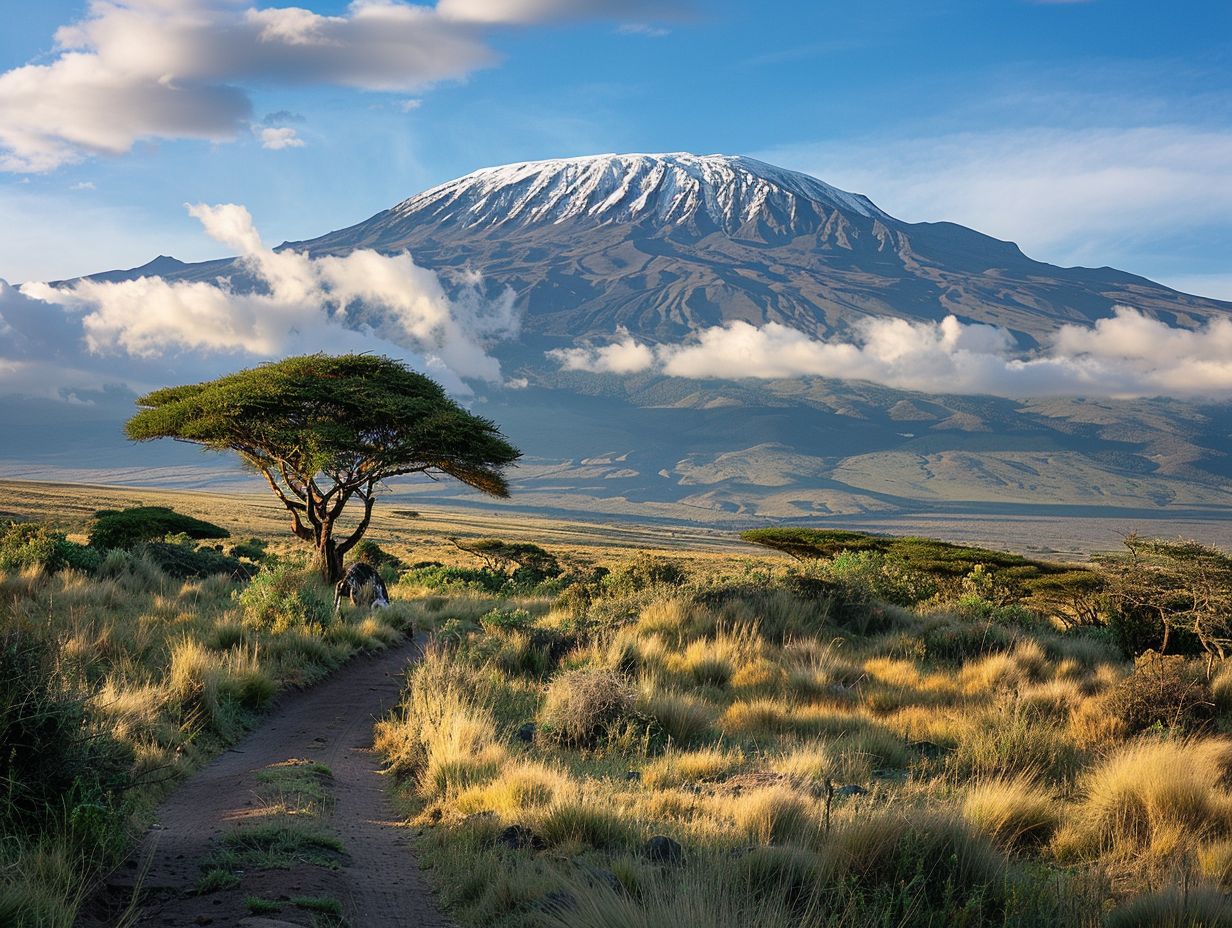
Located in Tanzania, Mount Kilimanjaro is the highest peak in Africa and one of the most iconic mountains in the world.
We will explore the geographical location of Mount Kilimanjaro, its physical characteristics, history, and culture, as well as provide tips for those looking to climb this majestic mountain.
Join us as we discover the country and continent where Mount Kilimanjaro is situated, its elevation, climate, terrain, and much more. Let’s begin our journey to the roof of Africa!
Key Takeaways:

- The location of Mount Kilimanjaro is in Tanzania, a country in East Africa.
- Mount Kilimanjaro is located on the African continent and is the highest peak in Africa.
- With an elevation of 19,340 feet, Mount Kilimanjaro has a diverse climate and terrain, making it a challenging but rewarding climb.
Geographical Location of Mount Kilimanjaro
Mount Kilimanjaro, located in Tanzania, Africa, is situated at the coordinates of 3.07°S latitude and 37.35°E longitude. It is part of the Great Rift Valley, a geological feature that extends across East Africa.
Mount Kilimanjaro, towering at an impressive height of 19,341 feet (5,895 meters) above sea level, serves as the highest peak in Africa. Its immense presence dominates the skyline and attracts adventurers and nature enthusiasts from around the globe.
As an icon of Africa, Mount Kilimanjaro holds significant cultural and spiritual importance to the indigenous Chagga people. They refer to this majestic mountain as ‘Kilema Kyaro,’ which loosely translates to ‘Mountain of Greatness.’
What Country is Mount Kilimanjaro Located In?
Mount Kilimanjaro, the highest mountain in Africa, is located in Tanzania.
Located in the northeastern part of Tanzania, Mount Kilimanjaro is an iconic natural wonder that rises majestically above the East African plains. This towering peak is a dormant volcano with three distinct volcanic cones: Kibo, Mawenzi, and Shira. Its summit, Uhuru Peak, stands at an impressive elevation of 5,895 meters (19,341 feet) above sea level. Kilimanjaro’s snow-capped peaks are a breathtaking sight and a major draw for adventurers and nature enthusiasts from around the globe.
What Continent is Mount Kilimanjaro Located In?
Mount Kilimanjaro, an iconic volcano, is located on the continent of Africa.
Located in northeastern Tanzania, Mount Kilimanjaro is Africa’s highest peak and the tallest freestanding mountain in the world. It is part of the Kilimanjaro National Park, a UNESCO World Heritage Site that encompasses a diverse range of ecosystems, from cultivated land to lush rainforest and alpine desert.
The mountain comprises three volcanic cones: Kibo, Mawenzi, and Shira. Kilimanjaro is a popular destination for climbers and trekkers, attracting thousands of adventurers each year to challenge themselves on its challenging slopes and witness breathtaking views from the summit.
Physical Characteristics of Mount Kilimanjaro
Mount Kilimanjaro, standing as the highest mountain in Africa, features multiple volcanic cones, with Uhuru Peak marking the summit. The mountain’s geological composition is that of a stratovolcano, showcasing its unique characteristics.
The presence of glaciers on Mount Kilimanjaro adds another layer of fascination to its already awe-inspiring profile. The mountain’s snow-capped summit forms a stark contrast to the lush surrounding plains of Tanzania. These glaciers are believed to be remnants of the last Ice Age and are a significant indicator of the changing climate.
The trek to the summit of Mount Kilimanjaro is a popular bucket-list adventure for mountaineers and nature enthusiasts from around the world. Climbing this majestic peak offers not only a physical challenge but also a chance to witness breathtaking views of the African landscape from the highest point on the continent.
What is the Elevation of Mount Kilimanjaro?
Mount Kilimanjaro’s highest point, Uhuru Peak, reaches an elevation of 5,895 meters (19,341 feet) above sea level. This extinct volcano offers climbers breathtaking views from its summit.
Standing tall at such a remarkable height, Uhuru Peak holds immense significance for climbers worldwide, attracting adventure enthusiasts from all corners of the globe. The challenging ascent and the sense of accomplishment upon reaching the summit make it a coveted goal for many.
Being an extinct volcano, Mount Kilimanjaro provides a unique opportunity for hikers to experience the grandeur of a dormant natural wonder and witness the fascinating geological formations that shaped this iconic landmark.
What is the Climate Like on Mount Kilimanjaro?

Mount Kilimanjaro exhibits varied climatic zones due to its height, ranging from tropical at the base to an alpine climate near the summit.
The change in altitude leads to distinct temperature variations, affecting vegetation and wildlife across the mountain. As one ascends, the air becomes cooler and thinner, creating an enchanting transition from lush forests to rugged moorlands and eventually to barren alpine deserts near the peak.
The iconic glaciers that have crowned Kilimanjaro for centuries are now under threat from global warming, with studies showing a rapid retreat of the ice cap over the past decades. The dwindling glaciers signal not only environmental change but also raise concerns about water sources and ecosystems reliant on this vital reservoir of frozen freshwater.
What is the Terrain Like on Mount Kilimanjaro?
The terrain of Mount Kilimanjaro features a mix of volcanic rock, glacial valleys, and lush forests, shaped by geological processes and erosion over time.
These geological formations have been influenced by both past volcanic activity and the forces of weathering and erosion that have sculpted the mountain’s terrain into a diverse landscape. Erosion, particularly from glaciers and rivers, has played a significant role in shaping the valleys and ridges that define Kilimanjaro’s topography.
History and Culture of Mount Kilimanjaro
With a rich history and cultural significance, Mount Kilimanjaro is not only a UNESCO World Heritage site but also home to diverse flora and fauna protected within Kilimanjaro National Park.
Standing tall as Africa’s highest peak, Mount Kilimanjaro holds a special place in the hearts of locals and adventurers alike. The mountain has served as a source of inspiration for centuries, attracting countless climbers seeking to conquer its majestic summit. Its distinct snow-capped peak against the African sky has captured the imagination of artists, writers, and nature enthusiasts globally.
The designation of Kilimanjaro as a World Heritage site in 1987 solidified its status as a natural wonder deserving of protection. Kilimanjaro National Park, established in 1973, plays a crucial role in safeguarding the mountain’s unique ecosystem, supporting a wide array of plants and animals found nowhere else.
Exploring the slopes of Mount Kilimanjaro offers a glimpse into the rich cultural tapestry of the region, with local tribes such as the Chagga people residing in its foothills. Their traditional practices and beliefs are deeply intertwined with the mountain, adding layers of heritage and spirituality to the already awe-inspiring landscape.
What is the History of Mount Kilimanjaro?
Mount Kilimanjaro has a storied history of exploration and climbing, with notable figures like Hans Meyer and Ludwig Purtscheller being among the first to summit its peaks in the 19th century.
These early expeditions not only marked significant milestones in the history of mountaineering but also contributed greatly to the understanding of this majestic African peak. Hans Meyer, a German geologist, and Ludwig Purtscheller, an Austrian mountaineer, undertook daring journeys to conquer the summit of Kilimanjaro, documenting their findings meticulously.
The accounts of their adventures provided valuable insights into the challenges posed by Kilimanjaro’s unique terrain and helped pave the way for future climbers to navigate its slopes with greater knowledge and preparation.
What is the Cultural Significance of Mount Kilimanjaro?
Mount Kilimanjaro holds immense cultural significance for the local tribes surrounding its base, with various myths and folklore attributing mystical qualities to the mountain.
One of the tribes that holds Kilimanjaro dear is the Chagga people, who consider the mountain as a sacred entity that connects heaven and earth. Legends speak of spirits residing on its snowy peaks and forests, guarding the land and its people. Cultural significance of this natural wonder extends beyond mere geographic importance, deeply engrained in the traditions and ceremonies of these tribes.
The mythology surrounding Kilimanjaro often includes tales of gods and spirits dwelling within its slopes, influencing weather patterns and granting blessings to those who pay homage. These stories have been passed down through generations, shaping the way communities interact with and revere the mountain.
How to Get to Mount Kilimanjaro
Getting to Mount Kilimanjaro is convenient with Kilimanjaro International Airport serving as the main gateway. Travelers can find multiple routes from key locations like Arusha, Moshi, and Dar es Salaam.
When flying into Kilimanjaro International Airport, located near the town of Moshi, travelers have easy access to the majestic Mount Kilimanjaro. From the airport, visitors can choose from various transportation options, such as shuttles, taxis, or buses, to reach popular starting points for climbing the mountain.
In Arusha, a city known for its safari tourism, adventurers can also embark on their journey to Mount Kilimanjaro. The route from Arusha provides stunning views and diverse landscapes along the way, offering a memorable experience before even reaching the mountain.
For those exploring Dar es Salaam, the bustling port city, planning a trip to Mount Kilimanjaro involves taking a connecting flight to Kilimanjaro International Airport. The airport’s convenient location makes it a preferred choice for travelers seeking to begin their mountain expedition efficiently.
What is the Nearest Airport to Mount Kilimanjaro?

Kilimanjaro International Airport is the nearest airport to Mount Kilimanjaro, offering convenient access for travelers looking to embark on an adventure to Africa’s highest peak.
Located in Northern Tanzania, this airport serves as a crucial gateway for tourists and climbers from around the world seeking to reach the iconic Mount Kilimanjaro. The airport’s strategic proximity to the mountain significantly reduces travel time and enhances the overall expedition experience.
Mount Kilimanjaro is not only a UNESCO World Heritage Site but also a popular destination for trekking enthusiasts and nature lovers. Travelers often fly into Kilimanjaro International Airport to kickstart their journey towards conquering the majestic peak.
What is the Best Way to Reach Mount Kilimanjaro?
The best way to reach Mount Kilimanjaro is through Kilimanjaro International Airport, followed by selecting suitable transportation options or climbing routes based on personal preferences and experience.
Upon arrival at Kilimanjaro International Airport, travelers can easily access various transportation modes to venture towards the majestic Mount Kilimanjaro. Depending on one’s preference, one can opt for shuttle services, private transfers, or rental cars to reach the starting points of the different climbing routes.
Choosing the right climbing route is crucial to ensure a safe and enjoyable trek. Novice climbers may prefer the Marangu or Rongai routes, while experienced mountaineers might be drawn to the challenging Western Breach route. Each path offers unique landscapes and experiences, catering to different skill levels and time constraints.
Tips for Climbing Mount Kilimanjaro
Climbing Mount Kilimanjaro requires careful preparation to combat altitude sickness and ensure a safe ascent. Engaging experienced guides and following a proper acclimatization schedule are crucial for a successful climb.
Preparations for a climb to the summit of Mount Kilimanjaro should involve physical conditioning to enhance endurance and stamina. Consider investing in high-quality gear suitable for extreme weather conditions encountered at higher elevations.
Understanding the symptoms of altitude sickness, such as headache, nausea, and dizziness, can help in early detection and timely intervention. Incorporating rest days during the ascent allows the body to adjust to the decreasing oxygen levels and decreasing atmospheric pressure.
How to Prepare for Climbing Mount Kilimanjaro?
Preparing for a Mount Kilimanjaro climb involves gathering essential climbing equipment, undergoing necessary acclimatization exercises, and physical conditioning to adapt to the altitude challenges posed by Africa’s highest peak.
Climbers planning to conquer Mount Kilimanjaro should first ensure they have the appropriate gear such as sturdy hiking boots, insulated clothing, a reliable backpack, and a sleeping bag designed for cold conditions. They must gradually acclimatize to the high altitude by incorporating progressive altitude gains into their itinerary.
This allows the body to adjust to lower oxygen levels. It’s vital to engage in regular cardiovascular and strength training to build endurance and muscle strength, crucial for enduring the strenuous climbs on the mountain.
What to Pack for Climbing Mount Kilimanjaro?
When packing for a Mount Kilimanjaro trek, climbers should include essential clothing for various climates, high-altitude gear, sturdy footwear, and other equipment necessary for a safe and comfortable journey.
Proper clothing is crucial to withstand the mountain’s changing weather conditions; layering is key for adjusting to temperature fluctuations. Thermal base layers are essential to trap heat close to the body.
It is also vital to pack a waterproof and windproof jacket to shield against rain and strong winds. High-altitude gear such as insulated jackets, gloves, and hats are essential for the freezing temperatures at the summit. Sturdy hiking boots with ankle support ensure stability on challenging terrain.
Frequently Asked Questions
Where Is Mount Kilimanjaro?

Mount Kilimanjaro is located in Tanzania, a country in East Africa.
How tall is Mount Kilimanjaro?
Mount Kilimanjaro is 5,895 meters (19,340 feet) tall, making it the highest mountain in Africa.
What is the closest city to Mount Kilimanjaro?
The closest city to Mount Kilimanjaro is Moshi, which is located just south of the mountain.
Can I see Mount Kilimanjaro from any other country?
Yes, on a clear day, you can see Mount Kilimanjaro from neighboring countries such as Kenya and Uganda.
Is Mount Kilimanjaro a volcano?
Yes, Mount Kilimanjaro is a dormant volcano, but it has not erupted in over 360,000 years.
How do I get to the base of Mount Kilimanjaro?
You can fly into Kilimanjaro International Airport, located approximately 70 kilometers from the mountain, and then take a taxi or shuttle to the base. Alternatively, you can take a bus or drive to the base from nearby cities.